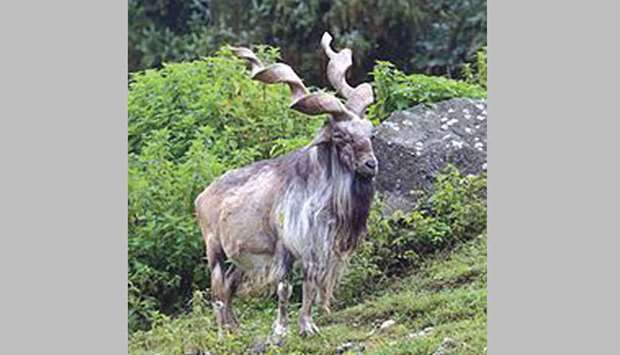Like armies they move at twilight, making tactical advance when least likely to be spotted. Only when light becomes shadows and the world loses substance that markhors move down from mountaintops to drink from the River Chitral in north of Pakistan.
Hayatuddin’s binoculars zoom in on a family of wild goats on Shahre Sham. The telescopic close-up turns the mountain’s rock face into a lunar surface. Up close, the Shahre Sham Twilight City in Persian – is just jagged brown rocks.
A quick movement, then nothing. The distance and the gathering gloom make the markhor hard to spot with the naked eye. Then, of all places, you see one atop a tree eating leaves. Versatile goats, they can climb trees.
They are not called markhor (snake-eater) for nothing. Hayatuddin swears he has seen one eat a snake. “First it crushes it under hooves. Then it eats the snake,” he recounts.
Hayatuddin is from Seen Lasht, one of the villages on this road at Garam Chashma in Chitral where the hot springs are. He has 30 colleagues working during a shift. The department of wildlife has organised Village Conservation Committees (VCC) to protect the markhors found in northern parts of
Pakistan.
Well until 2015, it had been declared an endangered species by the IUCN due to local poaching. The IUCN Red List of Threatened Species now puts it at ‘near threatened’ thanks to conservation efforts from the VCCs through a “hunters turning guards” policy, where habitats become game reserves. In Chitral, these protectorates are mainly owned by the royal family.
Hunting is done through licence from the wildlife department and part of the proceeds from hunting go to the VCC or tanzeem to encourage
preservation.
No more than three hunts are allowed every year in the game reserves of Chitral. This year there have been only two in the hunting season that falls between December and March.
The licence to hunt costs about Rs10mn.
In 1995, the IUCN brought markhor population under a sustainable-use wildlife management programme, in collaboration with the local communities in Gojal, Astore and Baltistan in Gilgit Baltistan, Chitral in Kyber Pakhtunkhwa and Tor Ghar in Balochistan. The programme provided legal protection for the species by establishing a hunting
regime.
Last year, the wildlife department in Gilgit-Baltistan auctioned licences for the trophy hunting of 113 rare species. The endangered Astore markhor fetched a neat $100,000, which is what makes conservation, both as a community incentive and a wildlife preservation
effort, desirable.
When poached by a local, a mountain goat only brings 30kg of meat. Through legal trophy hunting, it brings much more for the entire community.
“This is not the right law,” says Hayatuddin, looking away. He says there are lynx in the mountains that hunt the baby markhors. “It is not fair that the lynx kill them on one hand and hunters on the other.”

A markhor goat.


